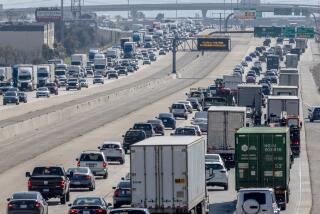County Cancer Pockets Are a Puzzle
- Share via
A review of reported cancer cases in Los Angeles County has revealed areas in the county’s southeastern region with unexpectedly high levels of throat cancer and a type of lung and bronchial cancer.
The review, by epidemiologist Dr. Thomas M. Mack at USC, provides no explanation of the cause for the higher-than-normal levels of the two cancers. They typically occur most frequently in smokers, but also can be affected by racial and ethnic factors and eating habits.
For the vast majority of the 84 kinds of cancer covered in the countywide review, Mack found no evidence of environmental causes. But he and other experts familiar with his research say possible environmental exposure, such as air pollution, should be investigated for the two cancers occurring at high levels in the southeastern county.
The review of 27 years of cancer reports found higher levels of oropharyngeal carcinoma -- cancer of the mouth and throat -- in several areas in and around Long Beach, including a strip of census tracts running north-south immediately east of the Long Beach Freeway between the two ports and the San Diego Freeway.
Higher levels of small cell carcinoma of the lung and bronchus were found in some contiguous census tracts in the southeastern portion of the county. This primarily occurred in an area bounded by the 710, 405, 105 and 605 freeways.
Mack’s review of cancer data stemmed from years of watching communities worry -- often needlessly -- about a neighborhood toxic site or other potential pollution sources, he said. Mack wanted to show people that cancer patterns often can be caused by other factors, such as age, behavior, social class and work history.
“Neighborhoods may be at high risk because of the people that live there,” he said. In fact, unlike some scientists, Mack believes that no U.S. cancer clusters have been clearly tied to environmental factors, even at such well-known sites as Love Canal in Niagara Falls, N.Y.
In Mack’s review, Kaposi’s sarcoma, a cancer largely associated with AIDS, shows up in a band from West Hollywood to Silver Lake -- home to a large gay population. Mesothelioma, caused by asbestos, was found in higher levels in men living north of Long Beach, where shipyard workers were exposed to asbestos during and after World War II.
Less clear is why high levels of oropharyngeal carcinoma and small cell carcinoma were found in southeast areas of the county.
Several of those areas are downwind of industrial facilities, such as the Los Angeles-Long Beach port complex, oil refineries and manufacturing plants, as well as the 710 Freeway. Scientists have found evidence linking air pollution to lung cancer, but have found no such tie with the less common throat cancer.
“I don’t know that this is air pollution, but it is worth a shot to try to find out whether it is,” Mack said of the cases grouped in the southeast county.
Several experts agreed that the findings deserved more study.
“This is a hint, a clue, an important starting place to see what may be happening,” added David Ropeik, director of risk communication at the Center for Risk Analysis at the Harvard University School of Public Health, when told of Mack’s study. “This may or may not hold up as we do further study.”
Scientists attempting to study links between cancer and pollution face a myriad of problems, including incomplete family histories, faulty monitoring data and the subtleties of cancer epidemiology.
Mack heads the California Environmental Protection Agency scientific advisory committee that decides which substances the state should list as carcinogens. He is chief of epidemiology at the USC Norris Comprehensive Cancer Center.
Mack reviewed data on 84 kinds of cancer reported by doctors countywide from 1972 to 1998 to the Cancer Surveillance Program, the county’s cancer registry. He published the results in June in a book, “Cancers in the Urban Environment,” which was co-edited by Wendy Cozen and Myles Cockburn at the USC Keck School of Medicine.
Mack matched cancer cases with census tracts to see how the cancers occurred geographically. A census tract contains about 5,000 people.
To protect patient confidentiality, the registry forbids the public release of the number of cancer cases in each tract. So Mack identifies which census tracts have a significantly higher cancer risk, rather than list the actual number of cases that occurred.
Mack labeled as high risk only those tracts whose rates were more than 50% higher than the average county rate and which couldn’t easily be explained by chance. What especially caught his eye were higher levels of cancers in adjacent census tracts.
“The likelihood that five or six of them would line up is very, very small,” Mack said.
Directly east of the 710 Freeway, for instance, seven of the nine census tracts between the ports and the 405 Freeway showed up as high-risk areas for oropharyngeal carcinoma.
Women were diagnosed at a higher-than-average rate in four census tracts, men in two, and both sexes in one tract. The cancer also appeared at higher levels in a strip of tracts a few census tracts farther east.
Oropharyngeal cancer occurs most frequently in smokers, drinkers, and especially drinkers who smoke, Mack said. Also at risk are people who chew tobacco or have poor oral hygiene. Low-income people are at greatest risk.
Cancer experts said they did not know of any research linking oropharyngeal cancer and air pollution.
The other cancer -- small cell carcinoma of the lung and bronchus -- occurred more often in a horizontal strip of census tracts in south-central Long Beach and farther north in the area bounded by the 405, 605, 105 and 710 freeways. More high-risk tracts were found near the intersection of the 405 and 110 freeways.
This cancer is linked most strongly with cigarette smoking. In other parts of the country, it also has been tied to radon, other kinds of radiation exposure, and some workplace chemicals.
Mack said he was surprised that the high levels of small cell carcinoma did not occur in the same areas as squamous cell carcinoma, another form of lung cancer frequently caused by smoking. That suggests another factor may be at play with small cell carcinoma, he said.
He said workplace exposure, for example, could play a role.
Several recent studies have examined the potential health effects of diesel fumes and other air pollution from trucks, trains and ships serving the Los Angeles and Long Beach seaport area -- the largest air polluter in the five-county Los Angeles region. Diesel is considered a probable carcinogen.
“All of us in public health are concerned about the air pollution that’s likely to be caused by the ports and the trucks on the 710 Freeway,” Mack said.
Several scientists said more research should be conducted to learn why cancer rates were higher in some census tracts.
Deborah Winn, chief of the clinical and genetic epidemiology research branch at the National Cancer Institute, said that if she were to follow up on Mack’s work, she would focus on lung cancer, probably comparing patients with healthy individuals and examining such issues as where people lived and whether they smoked.
Oral cancer would be harder to study because it is less common, Winn said.
Air pollution experts also urged further study.
“What this [book] should say is, ‘OK, let’s go look at these issues in more depth,’ ” said Dr. John Froines, director of the UCLA Center for Occupational and Environmental Health.
But the fact that both cancers occur frequently in smokers makes follow-up research difficult, because the smoking histories of census tract residents are not known, said Francine Laden, an assistant professor of medicine at Harvard University’s Channing Laboratory.
The proximity of high-risk areas to freeways does not yet establish cause and effect, said Laden, when told of the study. “It’s diseases that make sense,” she said, “but this could be totally coincidence.”
More to Read
Sign up for Essential California
The most important California stories and recommendations in your inbox every morning.
You may occasionally receive promotional content from the Los Angeles Times.









